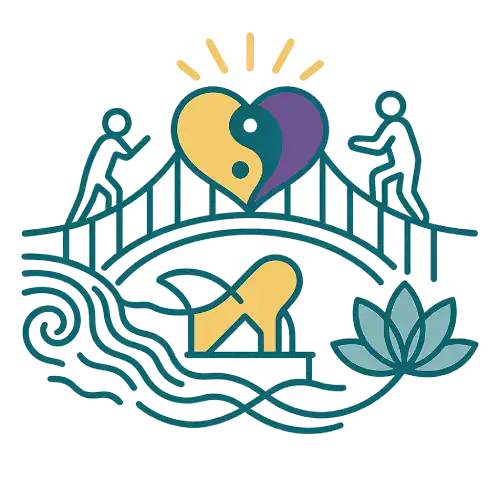Not all therapy is the same — and neither are the struggles we bring into it.
Some of us get trapped in spiraling thoughts: constant self-criticism, worst-case scenarios, endless overthinking.
Others get swept up in emotions that feel too big, too fast — reacting before we even have time to think.
When your thoughts sabotage you or your emotions take over, life doesn’t just feel hard — it feels out of control.
Therapy can help. But only if it targets what’s really going on beneath the surface.
Two of the most proven and practical approaches are Cognitive Behavioral Therapy (CBT) and Dialectical Behavior Therapy (DBT). They both offer real tools — but they’re built for different kinds of pain.
- CBT helps you catch and change the thought patterns that fuel anxiety, shame and stuck behavior.
- DBT helps you regulate overwhelming emotions, manage impulsive reactions and navigate conflict more skillfully.
So which one’s right for you?
Ask yourself this:
Is your biggest challenge calming your thoughts — or controlling what happens when feelings take over?Let’s break down the difference so you can find the approach that meets you where you are.
What is Cognitive Behavioral Therapy (CBT)?

Does your mind run wild with worst-case scenarios or relentless self-criticism?
You wake up already overwhelmed. You replay conversations, dread your to-do list and question your ability to get through the day. Your inner critic never lets up.
If it feels like your thoughts are constantly hijacking your mood, your motivation and your focus — CBT can help you take the wheel back.
What CBT Really Does
Cognitive Behavioral Therapy gives you more than perspective. It gives you structure, strategy and skills.
It targets the loops that keep you stuck: harsh thoughts, overwhelming emotions, reactive behaviors.
At its core is one guiding principle:
Your thoughts influence how you feel and how you act. Change your thinking and everything downstream starts to shift.
Why CBT Works
CBT is one of the most studied therapy methods — and the data backs it up:
- It reduces symptoms of anxiety and depression in 60–80% of cases
- It helps manage chronic pain and prevent relapse
- Long-term follow-ups show higher remission rates, fewer relapses and greater treatment durability than many other models
- Early improvement matters. Clients who respond in the first few sessions are significantly more likely to stay well long term.
CBT doesn’t just help in the therapy room. When you use the CBT toolkit consistently, you show up clearer, calmer and more in control — at work, at home and with yourself.
What You’ll Learn in CBT
CBT teaches you hows to interrupt patterns, challenge old scripts and respond more effectively when challenges arise.
Here are the core tools you’ll build:
- Automatic Thought Awareness: Catch the fast, often unconscious thoughts that trigger anxiety, shame or self-doubt.
- Cognitive Restructuring: Challenge exaggerated or unhelpful beliefs and replace them with grounded, flexible alternatives.
- Thought Records: Track thoughts and reactions to uncover patterns and create space for new responses.
- Behavioral Activation: Re-engage with activities that restore energy, pleasure and purpose
- Problem-Solving Skills: Break down challenges into manageable chunks so you can respond with clarity instead of panic.
- Coping Cards: Use short, written reminders that anchor you in moments of stress or overwhelm.
- Graded Task Assignments: Approach big, intimidating goals through small, doable actions that build momentum and confidence.
- Socratic Questioning: Use guided inquiry to shift rigid or fear-based thinking
- Exposure Therapy: Gradually face avoided situations to reduce fear and reactivity
They’re tools you’ll use when anxiety spikes, motivation crashes or your thoughts spiral into the familiar script of “I can’t do this.”
CBT gives you the skill set to meet those moments with clarity and control — not because life gets easier, but because you’ve gotten stronger at navigating it.
How CBT Works

Cognitive Behavioral Therapy gives you a clear structure: defined goals, practical tools and a roadmap for real change.
You don’t just talk about problems, you build skills to respond to them differently.
Here’s how the process typically unfolds:
- Create a Strong Partnership: From the start, CBT is a team effort. You and your therapist work together to identify what keeps you stuck and set clear, focused goals that move you forward.
- Spot the Patterns Driving Distress: Thoughts, emotions and actions form a feedback loop. The first step is uncovering the mental habits and behaviors that keep feeding the cycle.
- Learn the Cognitive Model: You’ll explore how distorted thoughts shape your mood and choices. Through exercises and reflection, you begin to see how certain thinking patterns fuel anxiety, shame or hopelessness and how to shift them.
- Challenge and Reshape Beliefs: With tools like guided discovery, evidence testing and cost-benefit analysis, you learn to question rigid thoughts and replace them with more balanced, reality-based perspectives.
- Practice Between Sessions: Change happens when you carry the work into real moments: your morning routine, your toughest conversations, your hardest days. Journaling, behavioral experiments and targeted exercises help you apply what you’re learning to real-life situations.
- Build Resilience Tools: You’ll develop strategies to manage emotional triggers, whether that’s deep breathing during a panic attack or using a coping card to ground yourself during a stressful confrontation.
- Reinforce Progress with Booster Sessions: Once your core goals are met, occasional check-ins help you stay on track, spot early warning signs and protect the gains you’ve made.
CBT is built on consistency. The more you use the tools, the more natural they become.
Most people experience meaningful shifts within a few months. For deeper or longstanding patterns, more time and support may be needed. Either way, you’re building lasting change — one skill at a time.
Common Issues Treated with CBT
CBT delivers powerful results for a wide range of mental health challenges, including:
- Anxiety disorders, including panic attacks
- Depression and other mood disorders
- Obsessive-compulsive disorder (OCD)
- Post-traumatic stress disorder (PTSD)
- ADHD
- Eating disorders
With CBT, you learn to rewire mental patterns so you can respond with clarity, strength and perspective.
What is Dialectical Behavior Therapy (DBT)?

Some emotions hit like a wave — sudden, intense and hard to control.
If you swing between moods, react before thinking or feel trapped in repeating conflicts, empowers you to stay steady in emotional storms, so you can think clearly, act with intention and protect what matters most.
Understanding DBT
Dialectical Behavior Therapy is a structured, skills-focused treatment developed by psychologist Marsha Linehan to help people facing intense emotions, impulsive behavior and chaotic relationships especially those living with Borderline Personality Disorder (BPD).
Over time, DBT has expanded far beyond its original purpose. It now supports people navigating depression, anxiety, PTSD, suicidal thoughts and patterns of self-harm.
One study showed a 77% drop in suicidal attempt within a year of DBT treatment — a striking measure of its impact. DBT is a long-term, skills-based therapy. Most programs run at least a year, with weekly sessions and structured practice.
At the core of DBT is a guiding principle: two truths can exist at once.
You can accept who you are now and work toward meaningful change.
DBT teaches you to pause before reacting, regulate emotional intensity and respond in ways that reflect your values — not just your triggers.
Core Skills You’ll Learn in DBT
DBT gives you a toolkit for managing intense emotions, building stronger relationships and replacing destructive habits with intentional choices. These are the six core skill areas:
- Acceptance and Validation: Learn to acknowledge emotions without shame or avoidance. Your therapist validates your experience while guiding you toward healthier ways to cope. This process builds emotional steadiness and deeper self-trust.
- Mindfulness: Build awareness of your thoughts, emotions and body in the present moment. Mindfulness gives you the space to notice what’s happening before it takes over so you can respond instead of react.
- Emotional Regulation: Develop the ability to recognize, name and manage strong emotions. By creating space between what you feel and how you act, you gain the power to choose your response instead of defaulting to reaction.
- Distress Tolerance: Learn how to survive emotional crises without making things worse. Tools include:
- Sensory grounding (sight, sound, touch, smell, taste)
- Distraction techniques to create space in overwhelming moments
- Radical acceptance: facing reality without resistance
- Interpersonal Effectiveness: Assert your needs, protect your boundaries and navigate conflict without sacrificing connection. DBT helps you communicate with clarity and self-respect, without sacrificing connection.
- Behavior Change: Identify the triggers behind impulsive or harmful behavior. Then, shift your actions in ways that align with your values and long-term goals.
These aren’t abstract ideas. You’ll learn them, practice them and use them — especially when life feels chaotic.
How DBT Works

Dialectical Behavior Therapy follows a clear, step-by-step path toward emotional stability, stronger relationships and a more grounded life.
DBT unfolds in four powerful stages, each one deepening your ability to stay present, respond intentionally and grow with purpose.
- Regaining Control: The first step is stabilization. If you’re stuck in cycles of emotional outbursts, impulsive behavior or self-harm, this stage helps you step out of crisis. You learn to ride the emotional wave without crashing, using distress tolerance tools that help you pause, breathe and stay in control.
- Processing Emotions and Healing Trauma: Once you’re out of survival mode, therapy goes deeper. You begin processing trauma, confronting shame and building emotional strength. Through mindfulness, radical acceptance and honest reflection, you learn to face your past without letting it control your future.
- Building a Life That Matters: With more stability in place, DBT shifts toward growth. You strengthen your relationships, set firm boundaries and start aligning your actions with your values. Whether that means reconnecting with loved ones, pursuing meaningful work or committing to your health, this stage focuses on building a life that feels worth staying present for.
- Sustaining Progress and Long-Term Growth: The final stage is about staying grounded and growing over time. You integrate DBT skills into daily life, using mindfulness, emotional awareness and flexibility to navigate whatever comes next. Booster sessions and monthly check-ins help reinforce progress, spot early warning signs and support your continued growth.
DBT takes time — but the foundation it builds is meant to last.
This isn’t surface-level change. It’s a deep, durable transformation that holds up when life gets hard.
Common Issues Treated with DBT
DBT is especially effective for:
- Borderline Personality Disorder (BPD)
- Bipolar Disorder
- Self-harming behaviors and suicidal ideation or thoughts
- Emotional dysregulation
- PTSD
- Eating disorders
- Substance-use disorders
DBT helps you stay steady in the face of intense emotions — so you can respond with intention, not reaction.
Looking For Therapy?
Start Healing Today.
212-960-8626
CBT vs. DBT: Core Differences

CBT and DBT stem from similar foundations, but they target different struggles with distinct strategies.
CBT focuses on thought patterns. You learn to catch distorted thinking, challenge it and shift your mindset to reduce anxiety, depression or avoidance.
DBT centers on emotional regulation and relationship skills. You build the tools to manage intense feelings, reduce impulsivity and respond to others with more balance and clarity.
Knowing the difference helps you choose the approach that fits your core struggle:
Are you trapped in unhelpful thoughts, or overwhelmed by emotional reactions?
Focus: Thoughts vs. Emotions
CBT and DBT both drive meaningful change, but they focus on different starting points.
CBT targets your thinking. It helps you catch distorted beliefs like catastrophizing or harsh self-blame and replace them with clear, realistic perspectives that shift how you feel and act.
DBT targets your emotional system. You learn to manage emotional surges, stay grounded in high-stress moments and communicate without fueling conflict.
Real-Life Examples
If your inner voice says, “Everyone thinks I’m awkward,” CBT helps you challenge that belief, test it against reality and practice healthier thinking that supports more confident behavior.
DBT helps you stay grounded in social situations by using mindfulness and body-based tools — so the anxiety doesn’t take over.
CBT helps you unpack the thoughts driving the anger and reshape how you interpret the situation.
DBT gives you real-time tools — like deep breathing or sensory regulation — to calm your body, hold your boundaries and speak with clarity instead of reacting.
In Short:
If your thoughts are the main problem, CBT gives you a roadmap to take back control.
If your emotions tend to spiral, or your relationships feel chaotic, DBT gives you tools to regulate, pause and reset.
Techniques: Reshaping Thoughts vs. Mindful Change
CBT and DBT use different strategies to help you take charge of your mental health.
CBT leans on cognitive restructuring. You learn to spot distorted thoughts, challenge them and replace them with clearer, more grounded ones. It also pushes you toward behavior change — like facing fears in small steps or building habits that lift your mood.
DBT centers on mindfulness and emotional acceptance. Instead of rushing to fix your thoughts, DBT teaches you to observe emotions without judgment. You create space for them to rise, peak and pass without reacting or shutting down.
Both approaches build strength.
Choosing the Right Fit
Not sure where to begin?
Start with what’s disrupting your life most — thoughts or emotions.
Here’s a quick side-by-side breakdown:
| Feature |
 CBT CBT
|
 DBT DBT
|
| Primary Focus | Thoughts and behaviors | Emotions and relationships |
| Best for | Anxiety, depression, OCD | BPD, emotional reactivity, self-harming behavior |
| Time Frame | Short-term (8-20 sessions) | Long-term (8-12 months) |
| Key Techniques | Cognitive restructuring, thought records | Mindfulness, distress tolerance, emotion regulation |
| Format | One-on-one sessions, with self-guided tools | Weekly individual therapy, group skills training, optional phone coaching |
In short:
- CBT delivers fast, structured support. It’s a strong fit for anxiety, depression or stuck thought patterns that fuel avoidance, fear or paralysis
- DBT combines deep emotional work with real-world tools. It helps when intense emotions, impulsivity or unstable relationships take over your day-to-day life.
You don’t need to have it all figured out to begin.
Many people start therapy unsure of what they need — and that’s okay.
Most skilled therapists take an eclectic approach, blending elements of CBT and DBT to match your unique challenges. They’ll help you explore both your thoughts and emotions, then shape a plan that fits your goals, patterns and strengths.
Which One is Right for You?

The right therapy begins with an honest look at what’s holding you back. When your approach targets the root of your struggle, progress becomes real and durable.
Who Benefits Most from CBT
CBT may be the right fit if you:
- Get stuck in negative thinking: Recurring anxious or self-critical thoughts pull you into fear, doubt or paralysis.
- Struggle with anxiety: Thoughts like “Something will go wrong” or “I can’t handle this” trigger stress and avoidance.
- Feel weighed down by depression: Harsh inner dialogue or hopelessness makes even small tasks feel exhausting.
- Crave structure and practical tools: You want clear strategies to shift your mindset, build momentum and function more effectively.
Who Benefits Most from DBT
DBT may be the better choice if you:
- Wrestle with intense, fast-changing emotions: Mood swings, emotional overwhelm or numbness disrupt your focus, behavior and relationships.
- Struggle to maintain stable relationships: Arguments escalate quickly, or you shut down and withdraw when things feel too hard.
- Need stronger emotional regulation: You want tools to stay grounded when emotions spike instead of reacting on impulse.
- Have trouble expressing your needs: You either hold everything in or express yourself in ways that create more conflict than clarity.
Choosing the right path starts with knowing your pain points and matching them with the tools that meet you there.
What If You Need Both? How Therapists Combine CBT and DBT
Thoughts and emotions don’t operate in isolation — and neither should your therapy.
Blending CBT and DBT can create a more complete path to healing, especially when your challenges cut across both thought and emotion.
Take social anxiety.
CBT helps you rework beliefs like “Everyone is judging me” into more accurate, balanced thoughts. DBT gives you tools to manage the physical and emotional intensity in the moment so you stay present instead of retreating.
For trauma survivors, the combination is just as powerful.
CBT supports the work of processing painful memories and shifting the beliefs that grow out of trauma. DBT adds emotional regulation and grounding techniques that keep you from feeling overwhelmed while doing that work.
Many therapists draw from both approaches, helping you shift how you think, while also strengthening how you respond to emotional stress, conflict or crisis.
If you’re managing overlapping struggles — like trauma, anxiety, mood swings or attention challenges — a blended approach can target the full picture with more precision.
CBT and DBT take different routes, but both build self-awareness, emotional strength and the ability to move through life with more clarity and control.Whether you start with one or blend both, the right fit won’t just reduce symptoms — it will move you forward.
Finding the Right Path to Healing

CBT and DBT both deliver meaningful results. The best fit depends on what you’re struggling with most.
If your thoughts feel like constant sabotage, CBT helps you shift that inner voice and break the patterns that keep you stuck.
If emotions hit hard or relationships feel chaotic, DBT gives you the tools to stay grounded, manage intensity and build deeper connections.
You don’t have to figure this out alone.
At Manhattan Mental Health Counseling, our licensed therapists offer both CBT and DBT. We listen closely, then tailor your therapy to match your goals, challenges and the pace that feels right for you.
Effective therapy isn’t just about symptom relief.
It rewires how you handle your thoughts, emotions and relationships.When you’re ready to stop circling the same patterns and start creating real, lasting change, we’re here to help you take the first step.

